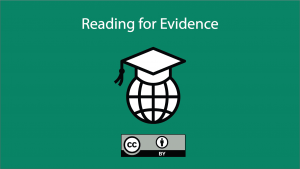We’ve expanded the library’s series of Research Help Videos over the summer ! These videos provide short (5-minute) orientations to key concepts and strategies essential to successful college-level research. Read snippets about the newly added videos below, and find links to check them out for yourself:
! These videos provide short (5-minute) orientations to key concepts and strategies essential to successful college-level research. Read snippets about the newly added videos below, and find links to check them out for yourself:
Reading for Evidence explores how reading like a researcher (i.e. reading for the evidence an author cites or contributes) is different from other kinds of reading. It is intended for students who are just beginning to navigate and make sense of scholarly articles, and meant to offer both a framework for encountering scholarship and reassurance that it’s okay if you don’t understand everything in a piece of scholarship (no one but the authors’ fellow specialists will!)
Scholarly Source Fakeouts reinforces that the peer review process is ‘what makes a scholarly source scholarly.’ It also examines several kinds of sources students commonly mistake for scholarly materials, including think tank publications, professional or trade journals, government reports, and book reviews within academic journals.
Who’s in a Position to Know? offers a heuristic for students to decide what information sources are worth their valuable time and attention: asking what puts an author in a ‘position to know’ something or equips them to contribute meaningfully to the conversation. Using a hypothetical example, the video explores what exactly constitutes authority and credibility in a given context.
What Good is Journalism? is a sequel to our earlier video, What Good is Wikipedia?, introducing students to the nuts and bolts of journalistic process and purpose, and outlining a few major types of journalistic sources they are likely to encounter.
Database Search Basics models an introductory search within the library’s databases, highlighting a few useful tips, filters and features to keep in mind along the way.
These videos can be accessed using the green ‘Research Help Videos’ button on the library homepage, or better yet you can add them to your Moodle shells as assigned or supplemental viewing alongside research-centric assignments. Don’t hesitate to reach out for help embedding or using these videos, or if you want to have a conversation about ways to connect the videos to specific assignments, exercises, or course goals.

